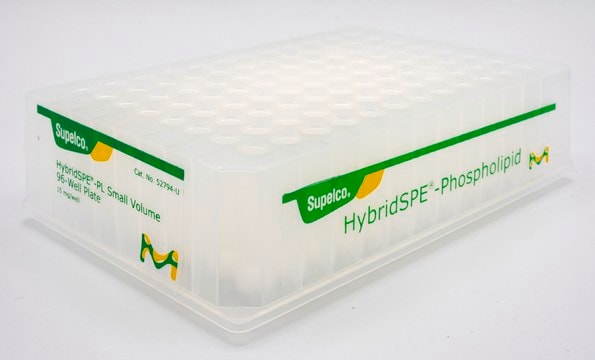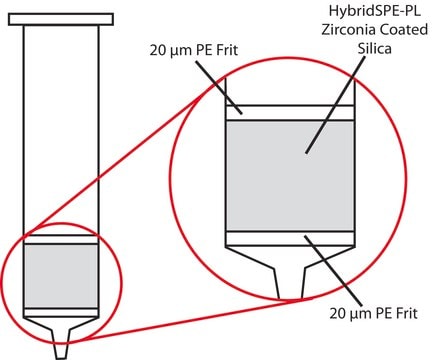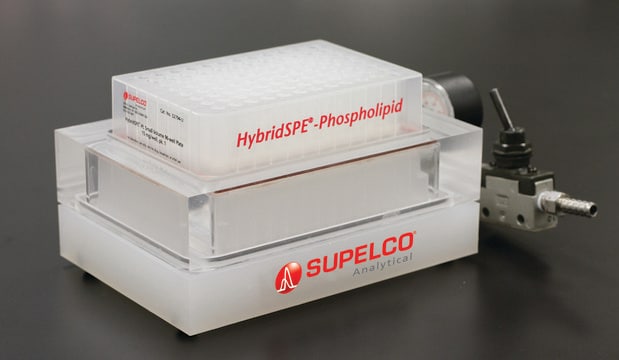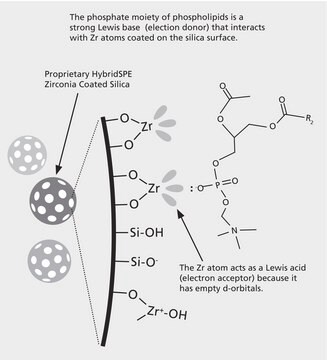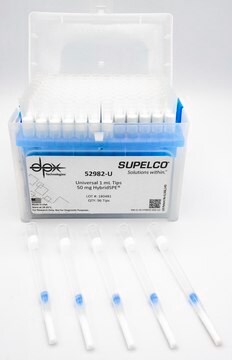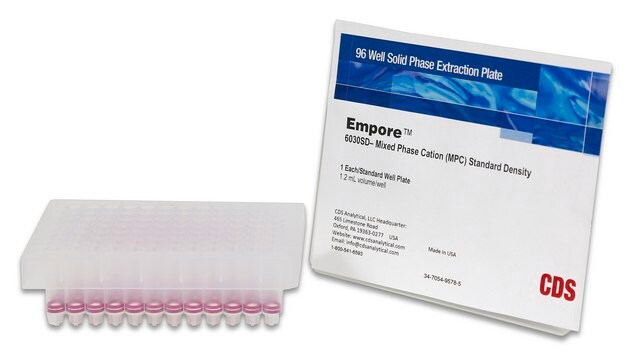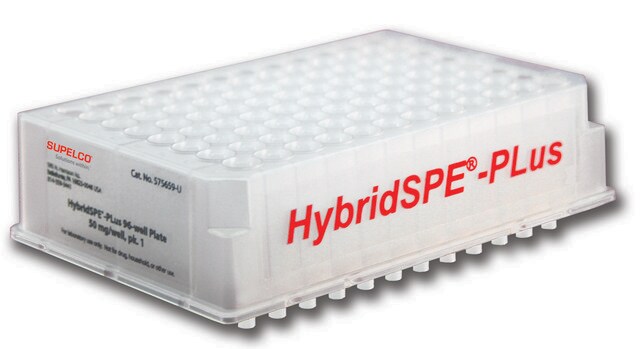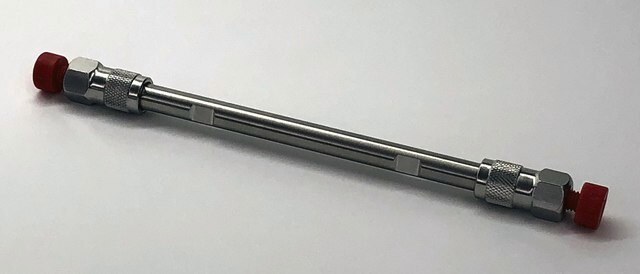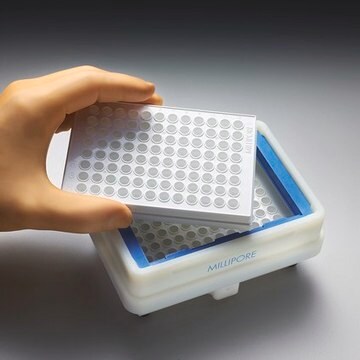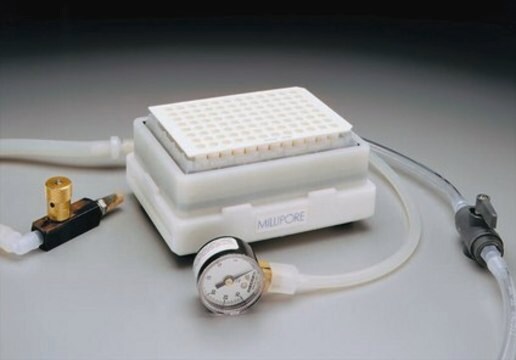575656-U
HybridSPE®-Phospholipid 96-well solid phase extraction (SPE) Plate
Volume 2 mL, bed wt., 50 mg, pk of 1
Synonym(e):
HybridSPE (phospholipid and protein removal) 96-well plate, 50 mg
About This Item
Empfohlene Produkte
product name
HybridSPE®-Phospholipid, 96-well Plate, bed wt. 50 mg, volume 2 mL, pk of 1
Qualitätsniveau
Produktlinie
HybridSPE®
Form
solid
Zusammensetzung
bed wt., 50 mg
Verpackung
pk of 1
Methode(n)
solid phase extraction (SPE): suitable
Volumen
2 mL
Aktive Matrixgruppe
zirconia-based phase
Suchen Sie nach ähnlichen Produkten? Aufrufen Leitfaden zum Produktvergleich
Allgemeine Beschreibung
Die „In-Well“- und „In-Cartridge“-Fällungsmethoden sind für die 96-Well-Version von HybridSPE-Phospholipid und die Kartusche von HybridSPE-Phospholipid Ultra verfügbar. Dabei wird zunächst biologisches Plasma oder Serum auf die Mikrotiterplatte bzw. in die Kartusche gegeben und dann gesäuertes Acetonitril, das Fällungsmittel. Nach kurzem Mischen/Vortexen wird Vakuum angelegt. Da die Versionen 96-Well und Ultra-Kartusche zahlreiche hydrophobe Filter/Fritten mit geringer Porosität enthalten, funktioniert der gepackte Filter bzw. die gepackte Fritte als Tiefenfilter und ermöglicht so während der Extraktion die Entfernung von sowohl Phospholipiden als auch gefällten Proteinen. Die standardmäßigen HybridSPE-Phospholipid-Kartuschen erfordern eine „Off-line“-Fällung.
Anwendung
- Rapid analysis of 65 pharmaceuticals and 7 personal care products in plasma and whole-body tissue samples of fish using acidic extraction, zirconia-coated silica cleanup, and liquid chromatography-tandem mass spectrometry: This study discusses the advanced application of chromatography and mass spectrometry, which could involve the use of technologies like HybridSPE®-Phospholipid for sample preparation, specifically for rapid analysis in biological matrices (Tanoue et al., 2020).
- Multi LC-MS/MS and LC-HRMS Methods for Determination of 24 Mycotoxins including Major Phase I and II Biomarker Metabolites in Biological Matrices from Pigs and Broiler Chickens: Demonstrates how LC-MS/MS, potentially incorporating HybridSPE®-Phospholipid technology for sample cleanup, facilitates the sensitive and accurate detection of mycotoxins in complex biological samples (Lauwers et al., 2019).
- Evaluation of an Ion Trap Toxtyper Liquid Chromatography With An Ion Trap Mass Spectrometric Instrument (Toxtyper) for Drug of Abuse Screening in Oral Fluid: Explores the utility of specific LC-MS/MS methodologies which could integrate HybridSPE®-Phospholipid for bioanalytical sample cleanup, enhancing drug screening accuracy (Plecko et al., 2018).
- Effective phospholipid removal from plasma samples by solid phase extraction with the use of copper (II) modified silica gel cartridges: This research potentially aligns with the use of HybridSPE®-Phospholipid technologies for phospholipid removal, focusing on enhancing the purity and quality of chromatography samples (Flieger et al., 2017).
- Liquid chromatography mass spectrometry determination of perfluoroalkyl acids in environmental solid extracts after phospholipid removal and on-line turbulent flow chromatography purification: Illustrates a specialized application of chromatography and mass spectrometry where HybridSPE®-Phospholipid could be applied to improve the analysis of environmental samples by efficient phospholipid removal (Mazzoni et al., 2016).
Leistungsmerkmale und Vorteile
- Vereint die Einfachheit der Proteinfällung mit der Selektivität der Festphasenextraktion (SPE) durch die gezielte Entfernung von Phospholipiden
- Reduziert die Ionenunterdrückung durch vollständige Entfernung der Phospholipide und gefällten Proteine
- Zwei- bis dreistufige generische Methode
- Geringe bis keine Methodenentwicklung
- Als 96-Well-Platten und 1 mL große Kartuschen erhältlich
Rechtliche Hinweise
Anwendung
SPE-Röhrchen oder -Platte
Lagerklassenschlüssel
11 - Combustible Solids
WGK
WGK 3
Flammpunkt (°F)
Not applicable
Flammpunkt (°C)
Not applicable
Hier finden Sie alle aktuellen Versionen:
Besitzen Sie dieses Produkt bereits?
In der Dokumentenbibliothek finden Sie die Dokumentation zu den Produkten, die Sie kürzlich erworben haben.
Kunden haben sich ebenfalls angesehen
Artikel
This Sigma-Aldrich article continues to detail new methodology for the analysis of Vitamin D metabolites using HybridSPE-Phospholipid technology.
This study demonstrates the impact of various mobile phase modifiers on the separation; formate modifiers outperform acetate in terms of MS signals (or sensitivity) and chromatographic resolution.
Sigma-Aldrich.com presents an article focusing on ion-suppression and phospholipid contamination and some of their major causes and difficulties.
This Sigma-Aldrich article discusses how the HybridSPE-Phospholipid Technology works and how the phospholipids are removed.
Protokolle
his study demonstrates the analysis of Warfarin in plasma samples utilizing chiral and achiral (reversed-phase) LC-MS and effective sample prep to remove endogenous phospholipids
A simple method to enrich phospholipids from plasma samples, involving a HybridSPE-PPT 96-well plate that both retains phospholipids and removes precipitated proteins.
The conversion of clinical methods to LC/MS/MS offers advantages; however, is accompanied by a few limitations, notably interference effects from the endogenous sample matrix.
Chromatograms
application for HPLCapplication for HPLCapplication for SPE, application for LC-MSapplication for HPLCMehr anzeigenUnser Team von Wissenschaftlern verfügt über Erfahrung in allen Forschungsbereichen einschließlich Life Science, Materialwissenschaften, chemischer Synthese, Chromatographie, Analytik und vielen mehr..
Setzen Sie sich mit dem technischen Dienst in Verbindung.